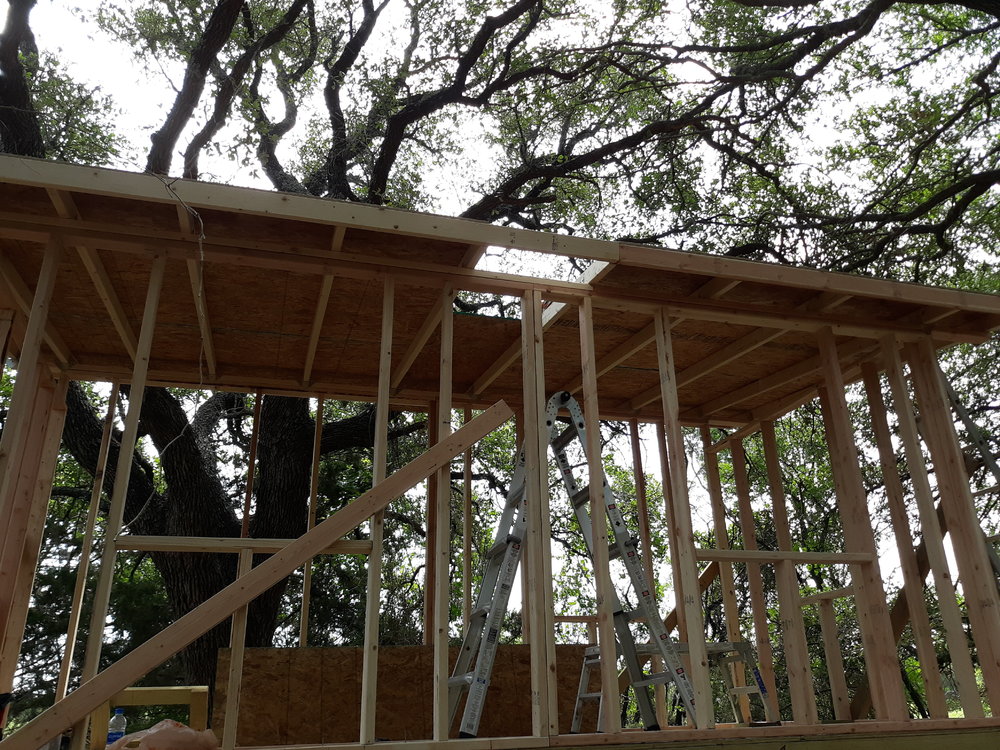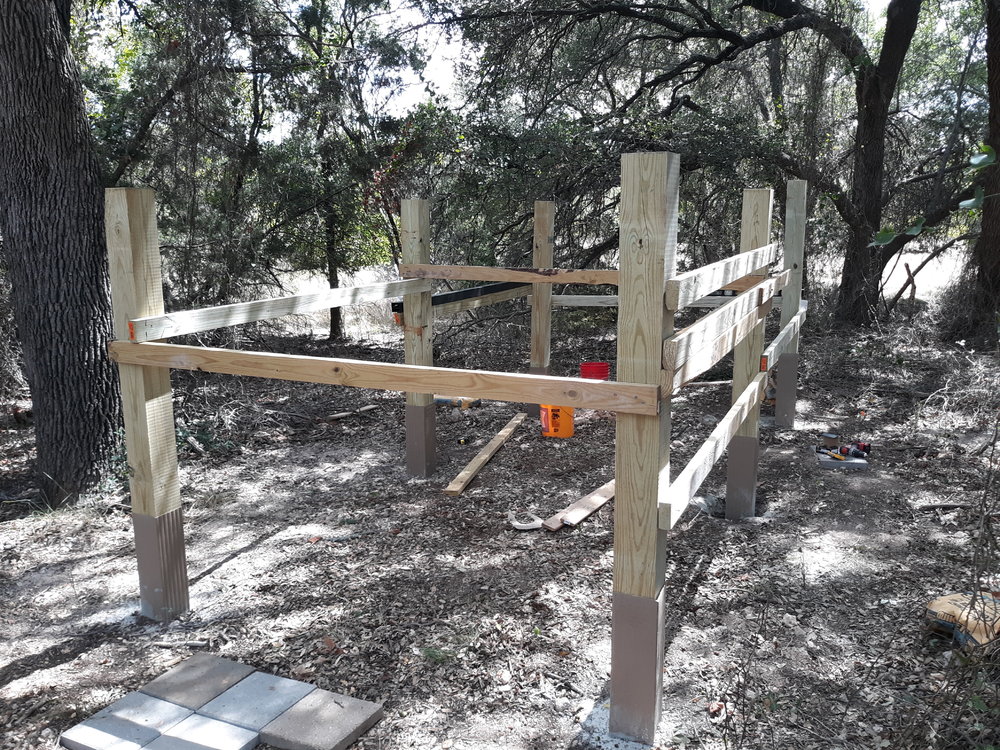
CleverNickname
Legacy Members-
Posts
1071 -
Joined
-
Last visited
Content Type
Profiles
Forums
Store
Downloads
Recruiting - 2020
2019-2020 Football Season
Football
Entertainment
Sports
News and Business
Cloak Room
Transfer Portal
Recruiting
Events
Everything posted by CleverNickname
-
I think I may have Covid-19 thread - 2 confirmed cases
CleverNickname replied to Gil Bang's topic in Daily Texan
Day 2 & 3 update from Horn of Gabriel & wife? -
Currently the plan is to put two (so 5x14) sets of scaffolding as a cheap/fast deck on the one side. And to hunt from.
-
Gonna paint outside this weekend. Then cut in siding for windows (framed up, just slapped up siding to be weather tight). May put in window ac too.
-
Idea: 8x16 ish elevated cabin thing for kiddos at our land. No plans. One side is 7'9" and one end is 7'8". Close enough to square. Six 8x8 posts, two beams are doubles 2x8s.
-
I'm pretty close to an AISD principal. The higher ups HAVE NOT requested from that single campus (and presumably other campuses): (1) a list of teachers with pre-existing conditions who simply cannot work face to face next semester. Of course these teachers should be on top of the list for teaching on-line classes. (They are also often the oldest teachers least familiar and adaptive to technology. Oh well. At least the spring helped them adjust a little. Oh, and btw: AISD is forcing an entirely different technology ecosystem from what was used in the spring that was designed for college students. I'm sure it won't be a hot mess for third graders...) (2) made a survey of classrooms assuming spacing restrictions to figure out how many classes and # of kids they can actually safely accommodate (assuming every possible art room etc is converted to a classroom). AISD is the most segregated district in the state. It is likely west side schools will open with fewer than 25% in physical attendance, and many east side schools will open with >75% attendance. There are scenarios where kids (and teachers) will need to be bused to campuses that have the physical space. Hi west side liberal parents who think they aren't racist: here are 80 east side students from a coronavirus hotspot, bused to your school. But nobody, as far as I can tell, have talked or discussed this.
-
Maybe one of these days I'll try to recreate the old La Casita cabin building thread on the old site. Image sites died. Plus the whole SB brouhaha. Currently building a 8x16 elevated cabin for my kiddos dubbed the "treehouse."
-
I've got 3 wildlife troughs that are fed by a rainwater collection system. My cabin has been off grid for years (only got electric run to it a couple years ago). Just built a shed roof last year that sole purpose is to fill a 500 gal tank that keeps a 60 gallon trough full on the other side of the creek. They work great! I've got a little low spot that keeps water, but it would be swell if I could pump it out and stored a little better. Probably 1500' from my power and cabin. I could do another water collector. But been there and done that. Basically I want to harvest the water from an intermittent hole. As a logic statement: If (hole > 0) AND (container < full) then pump into container/trough.
-
Awesome. I knew there had to be systems like this out there. Anything that would work as an off switch if the source goes dry?
-
I have a tiny water impoundment on my property. I wouldn't even call it a proper tank. I'd like to pump water up and out to a small water trough. Something between 60 and 300 gallons. Anyone have a good way to do this? I could easily pump it with a generator and a pump if I was there, but I'd like to try and figure out some way to have it work when I'm not there. Ideally I'd like something like an inexpensive wind generator or a solar panel working on a 12v sump pump. Probably wouldn't need more than 20 ft of lift. Maybe as little as 10 ft. If I could rig up a cut off that would be great. I've got a couple of wildlife water troughs that fill up via a float valve and a rainwater collection tank, but none of that is powered. I'm usually pretty good a googling a solution but this has me stumped. I must be missing something easy.
-
COVID-19 2nd wave - Texas only - Stats and such
CleverNickname replied to justhookit's topic in Daily Texan
Amen. My wife teaches elementary. Her usual day is 7:30 to 4:30 (20 minute lunch), with another 2-3 hours of work each night and on the weekend. Easily 60 hours per week. She does get the summer & winter break mostly off, which is nice for the kids. No crazy camp scramble. And to tie it back to covid, she teaches Rundberg area, which is one of the Austin-ara epicenters: https://www.kvue.com/article/news/health/coronavirus/austin-public-health-new-testing-sites-black-latino-communities/269-e78e6788-6c24-4069-ae6a-d9d71e134067 -
I'm being shelled in 78759.
-
When we first got married my wife and did a good MT trip. 2007 I think. Flew into Great Falls, did Missouri River by canoe from Fort Benton for 6 days. Then rented a car and did Glacier/Wateeton. Good times. Thinking of taking kids (11 and 9 next summer) and doing it again. I want to add an ice cave.
-
At every scenic overlook there are a multitude of signs that say "don't throw rocks." Sooner or later you will not be able to resist the urge to throw one tiny pebble in. One day humankind will fill in that hole. It is our destiny. But seriously, the GC is sort of meh. Its amazing, but its hot as balls in the summer and all you really do is kinda look at it. Hit up Zion and Bryce and do the North Rim.
-
Spouse teaches Rundberg area AISD. Virtually no one has internet at home. Eventually they got 2 or 3 buses revamped as wif hubs but that didn't cover all the kids. The busses were there for part of the day... the part of the day when their parents were not at home and often not keen on letting their elementary kids run free without supervision. Many if the families have already moved. Lost jobs and doubling up. And it's the margin of the district so often they bounce over to PfISD and that creates tracking problems. Those first graders just learning to read... they pretty much are screwed.
-
Renting a little place up near Uvalde. Neighbor 1 has a miniature pony dude. Cute little guy. Likes apples. Neighbor 2 has his own miniature pony. A little philly just across the road. So Neighbor 1 and Neighbor 2 decide it would be cute to breed em. Done deal. But now Mr. MiniHorse runs in circles all day. Wont stop moving. Losing weight. Won't eat enough. Just prances and huffs at girlfriend across the way. Little Philly doesn't care, chill as can be. /undefeated
-
Leakey - Concan - Uvalde - Vanderpool - Utopia
CleverNickname replied to CleverNickname's topic in Food and Travel
Lunch and swam a Utopia Park. Very nice. Got a cheap cabin on Dry Frio. Nice swimming hole 4 to 5 ft deep. Perfect for my kiddos. Kids even enjoyed neighbor goats which I didn't even think to mention to the. Garner day passes on the way out on Tues. Didn't being enough beer. Dry precinct. -
This is Texas. A Modern Texas. What Is A Ranch?
CleverNickname replied to ROFL BOX's topic in Daily Texan
Only have 35ac. Wildlife ag exempt. Very much an excuse to drive pickup to there, sweat my ass off, drink beer, and generally waste time. I say "I'm going up to the ranch." -
I also really like Driggs. Spent a few nights there when doing the Tetons. High was like 77 in July. Decent Tex Mex (or maybe just because we were hungry from hiking - I swear there was dusting of parmesan on my beans, but it was good enough and they had a bouncy house for the kids). I always laugh at the amount of potatoes they shove into TexMex up in the UT/ID/MT/WY area. The grocery store is pretty great for being in the middle of nowhere. I don't fish, but I imagine it would be great fly fishing. Drove into Driggs for the first time coming from Yellowstone. It was dark, one of those late afternoon summer storms. Kids and wife were asleep. Isbell's Traveling Alone came on as I neared the top of the pass. Bliss. Yellowstone is my favorite place on earth. I can't imagine blitzing it in a single day. Better than never seeing it, I guess. I remember pulling off a road just past a little bridge, I forget why. Maybe so the kids could stand on a pile of snow or something. There is snow in the passes through July. Anyway, under the bridge was a steaming fumerole. Not even marked on the map or had a sign. But a steaming, gurgling portal to hell itself was there, belching sulfur and a rivulet of hot water made pink and red and orange mats of thermophile algae. Like there so many crazy geological features that what we would have built an entire state park in Texas around is basically forgotten. Hot springs are amazing. Geyers are fucking double amazing. Mud pots, fumeroles (dragon's mouth - holy shit) are amazing. Flowstone deposits are cool as hell. You'll be walking along some boardwalk and a geyser will erupt and holy jesus fuck! Maybe it erupts every couple hours, but if you walk by hundreds there's a good chance you'll see one go that only does it every week or so. And you saw that, something that might just be a little placid spring for hundreds of other folks. The evolution of the springs and fields is also amazing (article link below). You may come back a few yeas later and an entire new area is becoming thermally active, and yet an old area is losing its fizz. And just when you get mildly used to those, you realize you are in the middle of this gorgeous boreal wilderness. The river and gorge and waterfall is tremendous. Taking a picnic along the Snake and swimming in a hot spring. Washing your hiking sweat off in the Boiling River swimming area. Elk and buffalo and bears. So many bears. And wolves. Hell, even Thermopolis is pretty rad, IMO. The lake is so pretty, and you gotta love the thermal features under the water. Seeing where the old wildfires were, and where the new growth is. Repeating the same dad lecture to the kids on how interesting the Continental Divide is every time you cross it (you cross it so many times). Hydrological basins are interesting as hell. It's super weird that the HEB on Spicewood drains to the Brazos, but one block over the storm drain goes to the Colorado. Its like that, only a different fucking ocean. One day I'm gonna hike to Two Ocean Pass, eat an edible, and figure it all out man. "Hey kids, were not in the Pacific hyrdological basin. That's a different ocean from back home. Oh wait, back over the divide. Now a cup of water poured here will flow all the way to the Gulf of Mexico!" They hate that, except that they secretly love that. If you are there for 5-6 days you can take some hikes to geyser fields and despite the crush of buses and whatnot, you might be the only people there for a couple of hours. I even (especially) love the signs with the parboiled child fucking dieing. Here's a crazy article that makes me want to get in the truck, drive 24 hours, get a backpacking permit and fucking go: https://www.usgs.gov/center-news/yellowstones-newest-thermal-area-close-and-personal-visit?qt-news_science_products=4#qt-news_science_products And shit, I forgot Quake Lake! That shit is lit!
-
Preach, brother. I've always rolled my eyes and cops who want to pretend they are playing GI Joe. But only now do I associate that kind of cosplay with systemic racism. Two years ago my kids elementary school had a fall festival and the police showed up with some armored surplus vehicle. I pointedly thanked the cops for coming, but pointedly told them "next year, please bring a regular squad car." I don't my kids thinking an armored division is 'normal' for police. To their credit the following year they did.
-
Leakey - Concan - Uvalde - Vanderpool - Utopia
CleverNickname replied to CleverNickname's topic in Food and Travel
Plans thus far: • Swam, kayaked, and SUP on Lake LBJ this week for a bit. My in-laws have a place in Grabite Shoals in the water. May go back soon hit the Slab near Kingsland early on a weekday soon while the Llano is flowing. • Will walk the South San Gabriel off 183 next week on a weekday, before the summer dries it up. Dino tracks and wading. • Got a cheap place for a couple of nights on the Dry Frio in June. Just me and the family. Already have day passes for Garner and Lost Maples. • Day pass for Guadalupe River State Park for late June. • Locked up 3 nights near Hunt on the Guad for July. • Got 5 nights on the Frio near Leakey in August. Splitting it with my sister in law. The cousins have a ball together. Will do day trips and passes from there. • Still pending: Perdanales SP and Colorado SP. Maybe Blue Hole in Georgetown. Been meaning to check out Hancock Springs in Lampasas (currently closed for out of county residents). May pass up the Wimberly area swimming holes this year. I figure they may be too crowded. Ditto for Guad and Comal near NB. Might check out Devils Watering Hole. Not sure if the kids would hime to Barton Creek greenbelt places (and they might be busy). -
Leakey - Concan - Uvalde - Vanderpool - Utopia
CleverNickname replied to CleverNickname's topic in Food and Travel
Nabbed park reservations for Lost Maples and Garner for next month! -
Leakey - Concan - Uvalde - Vanderpool - Utopia
CleverNickname replied to CleverNickname's topic in Food and Travel
I nabbed a couple of nights in June at a place with shared Dry Frio access, and am sharing a bigger house with SIL and nieces on West Frio north of Leakey just before school (hopefully) returns. But I can easily take off more days and pop down a time or two. Plus when we they are there for a week I am willing to brave a popular float with some of the kiddos.
Football ... Basketball ... Baseball ... Other Sports ... Futbol ... 🤫995🤫 ... Gambling ... Movies & TV ... Music ... Hobbies ... Lulz ... Food & Travel ... Daily Texan ... Business and Markets ... Cloak Room ... Help ... For Sale ... Board Discussion ... Subscribe!... Donate!... Advertise... COOKIE MONSTER!







